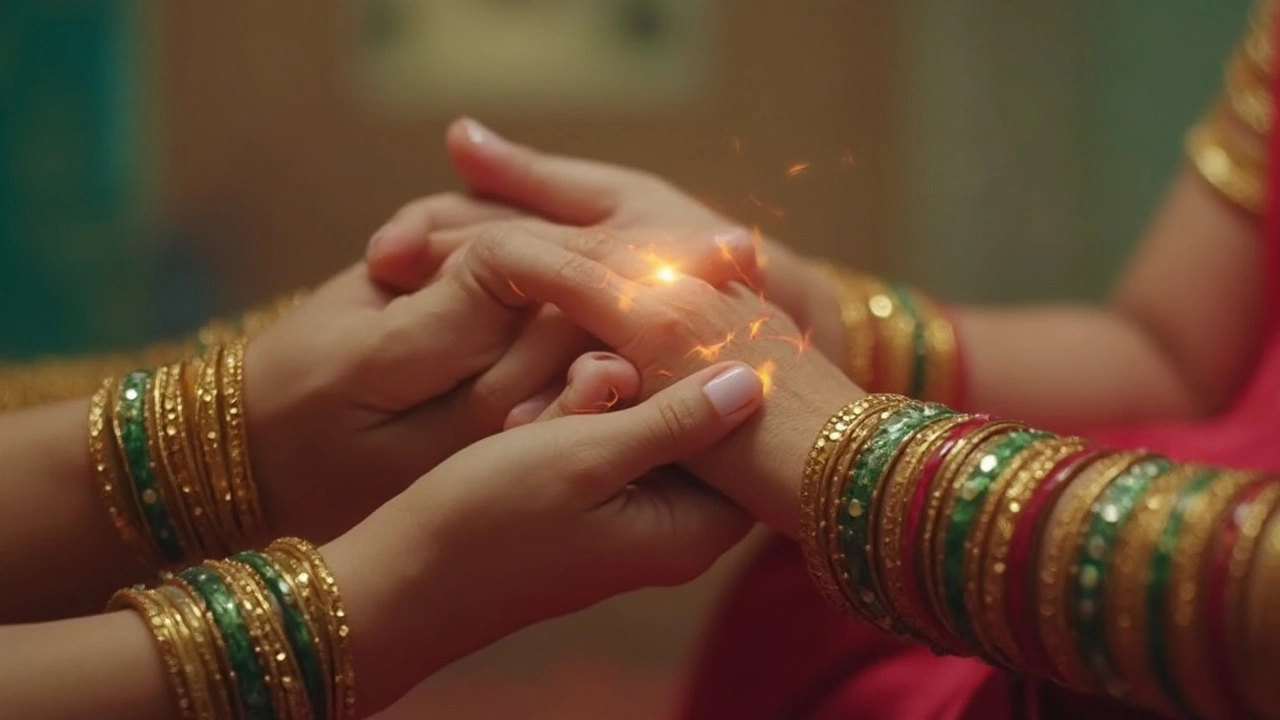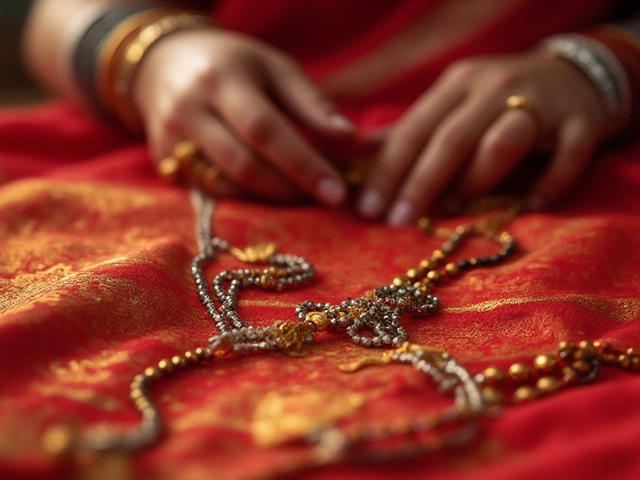Bangles aren't just pretty accessories. For generations, women across India have worn them almost as a daily ritual, but most people don’t realize there’s actually some science behind this habit. It sounds wild, right? But it’s not just about looking good for festivals or weddings—there’s more going on under the surface.
The idea links back to ancient times when people believed wearing bangles helped with better blood circulation in the wrist area. The gentle pressure and constant movement of metal bangles can create tiny vibrations. Some folks say this might stimulate acupressure points around your wrists. Modern studies haven’t debunked these claims, and you’ll even hear some doctors mention that any regular, subtle movement can improve micro-circulation. That means less wrist stiffness and potentially warmer fingers—definitely not something you’d guess from a jewelry box.
It doesn’t stop at circulation. The choice of metal matters too; gold, glass, copper, and even silver bangles have their own place in traditional beliefs. Each material was picked not just for looks, but for small ways it could interact with the skin and body temperature. If you’ve ever swapped out a metal bangle for one made of plastic, you know it feels totally different—sometimes, cultural wisdom just makes sense in daily life.
- What Makes Bangles Special in Indian Culture
- Science and Body: How Bangles Interact With Your Health
- Materials and Their Surprising Effects
- Choosing and Wearing Bangles: Tips for Comfort and Benefit
What Makes Bangles Special in Indian Culture
If you’ve ever been to an Indian market or a family function, you know bangles are everywhere. But there’s a real reason behind their deep connection to Indian life—not just style, but serious meaning and everyday use.
Bangles are a big deal in Indian traditions, especially in weddings and festivals. You’ll notice married women almost always wear them, and they’re one of the first pieces of jewelry that little girls receive. It’s not just for show. In many regions, bangles are a symbol of good fortune and health. Breaking or losing a bangle can sometimes be seen as unlucky, especially for married women.
Different areas in India have their signature bangle styles. For example, Punjabi brides often get the famous red and white “chooda,” Gujarati women wear green glass bangles during weddings, and Bengalis have special “shakha pola” (conch shell and red coral bangles).
Here’s a quick snapshot of how some regions treat bangles:
| Region | Traditional Bangles | When Worn |
|---|---|---|
| Punjab | Chooda (red & white) | Weddings, newlywed period |
| Bengal | Shakha Pola (conch & red coral) | Post-marriage |
| Maharashtra | Green glass | Weddings, fertility rituals |
| Gujarat | Ivory or green glass | Weddings, festivals |
Besides tradition, there are social reasons too. Wearing bangles often signals marital status and even family background. Some communities use specific colors and materials to show their heritage. Plus, the sound of bangles—the soft clinking—is considered a sign of positive energy at home.
- Bangles are believed to bring luck and keep away negative vibes.
- For many, bangles are an everyday part of life, not just an accessory for special occasions.
- Gifting bangles is common during baby showers, weddings, and festivals like Diwali.
So, while they add color and shine, bangles are packed with cultural code. It’s not just what you wear but what it says about who you are and where you come from.
Science and Body: How Bangles Interact With Your Health
This might surprise you, but wearing bangles isn’t just about tradition—there’s some logic behind it. It circles back to how blood flows in our hands. The wrist is packed with veins and acupressure points, so when you wear a snug bangle, it puts a light but steady pressure there.
Thanks to small movements of your hand and wrist all day (think texting, chopping veggies, or pulling out your wallet), these bangles gently nudge the skin. That micro-vibration is believed to kickstart better blood flow. Regular movement and pressure in that area might even help keep your hands less stiff and improve warmth, especially during cold weather.
“Repeated tactile stimulation, even from basic jewelry, can help maintain sensory response and promote healthy microcirculation.” — Dr. Anita Chhari, physiotherapist, Mumbai
It doesn’t end there. Here are some facts about how bangles interact with your body:
- Acupressure points: Traditional ayurvedic thinking says there are pressure points on the wrist. Bangles could stimulate some of these naturally while you go about your day.
- Reduction of Stress: The light contact and tiny sounds created by glass bangles can be calming. Some women say it helps with mood during stressful routines.
- Skin and Metal Interaction: Metals like silver and copper react with sweat. This might be why wearing them has been linked to cleaner skin and less bacterial buildup compared to wearing plastic or synthetic stuff.
Want real numbers? Check out this table that summarizes how different materials interact with your wrist health:
| Bangle Material | Potential Benefit | Common Experience |
|---|---|---|
| Gold | Hypoallergenic, does not tarnish easily | Gentle on sensitive skin |
| Silver | Antimicrobial, cooler temperature | Feels fresh and may help with sweating |
| Copper | May support skin health | Sometimes leaves green mark but easy to clean |
| Glass | No direct health effect, but calming sound | Lightweight, not too sweaty |
You don’t have to wear stacks of bangles to get these effects. Even one or two, as long as they fit well and aren’t too tight, can do the trick. So next time you see someone sporting those shiny circles, remember—it could be doing more for their health than you think.

Materials and Their Surprising Effects
Most people don’t realize that the material of a bangle isn’t just about style or matching your outfit. It can affect how your body feels, reacts, and maybe even functions throughout the day. In India, the main types you’ll run into are gold, silver, copper, glass, and lately, plastic. Each type carries its own quirks, and some even have backing from both traditional practices and a bit of science.
Let’s break down the usual suspects in the bangle world:
- Gold bangles: Besides making you feel fancy, gold is seen as a symbol of purity. In Ayurveda, it’s supposed to promote good energy and balance. Plus, gold doesn’t react with the skin, so you rarely see rashes or allergies. That’s why so many heirloom bangles are made of gold—it’s not just for the shimmer.
- Silver bangles: Silver is considered cooling and antibacterial. If you’ve ever noticed fewer skin problems with a silver accessory, you’re not alone. Some evidence hints that wearing silver can help keep the skin healthy, especially in humid places.
- Copper bangles: This one’s big in traditional medicine circles. Wearers believe copper helps reduce joint pain and inflammation. While the modern science jury’s still out, a few studies show a minor absorption of copper through the skin, which could be beneficial if you’re low on this mineral.
- Glass bangles: These are super popular during festivals and special occasions. While they don’t interact directly with the skin like metals, glass bangles make a distinct sound, which is said to keep positive vibes around. And believe it or not, some claim the gentle clinking can boost mood and energy—maybe that’s why they’re so popular at celebrations.
- Plastic bangles: Cheap and colorful, but there’s really no benefit other than looks. Plus, cheap plastics can irritate skin or even cause rashes, so they’re kind of the ‘use at your own risk’ choice.
To give you a quick, no-hassle comparison, here’s a table showing what each material is known for:
| Bangle Material | Main Perks | Possible Downsides |
|---|---|---|
| Gold | Non-allergic, durable, symbol of purity, believed to support good energy | Expensive |
| Silver | Cooling effect, antibacterial, skin-friendly | Needs regular cleaning to avoid tarnish |
| Copper | Believed to support joint health, minor mineral absorption | Might cause green stains on skin |
| Glass | Vibrant colors, festive sound, boosts mood | Fragile, can break easily |
| Plastic | Cheap, wide variety in style | Can irritate skin, no health benefit |
If you’re picking a bangle to wear every day or for a special event, think about what matters most to you—comfort, tradition, health, or just matching your outfit. And for anyone serious about health, sticking to metal bangles could be better than plastic. Bottom line: the scientific reason behind bangles gets a boost from what they’re made of, so choose smart.
Choosing and Wearing Bangles: Tips for Comfort and Benefit
If you want to get the most benefits from bangles, it’s not just about picking something that looks nice. There’s a little bit of know-how that goes into choosing the right pair—especially when you care about comfort and health, not just style.
Fit comes first. Your bangles should be snug enough to lightly touch your skin but not so tight that they leave marks or restrict blood flow. Bangles that are too loose won’t apply the gentle pressure that's linked to improved circulation, and they can even slip right off during daily activities.
- Measure your hand at its widest part (usually around the knuckles) instead of your wrist. Most jewelers use this for an accurate bangle size.
- If you wear bangles every day, avoid very heavy pieces—they can cause wrist fatigue or even mild pain over long periods.
- Listen to your skin. If you feel itching, rashes, or swelling, switch your bangle material. Glass, gold, and silver are less likely to cause allergic reactions than nickel or cheap mixed metals.
Material isn’t just about allergies. For those interested in the health benefits of bangles, metals like copper and silver have a solid reputation. Some people believe copper can help with joint pain and promote healing. There’s evidence that silver has antibacterial traits, and that’s why a lot of folks still pick silver for daily wear. Plastic bangles may be lightweight, but they don’t have the same reputation in traditional Indian culture or in these scientific claims.
Here’s a neat tip—try stacking lighter bangles instead of one heavy one. You’ll get more surface area touching your skin, and those gentle movements add up throughout the day. If you’re looking for balance between tradition and comfort, try mixing metals with glass. You get variety, it looks cool, and glass bangles, especially, are not only beautiful but also very lightweight.
Finally, remove your bangles at night. This gives your skin a break and lets you check for any irritation you might have missed during the day. Cleaning your bangles weekly, especially if you sweat a lot or live somewhere humid, will keep them looking fresh and reduce your chances of skin reactions. So next time you pick out bangles, think beyond the outfit—they might surprise you.



